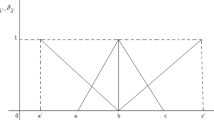Abstract
This paper studies a bi-level non-linear multi-objective decision making (BLN — MODM) problem with linear (or nonlinear) constraints, and in which the objective function at each levels are nonlinear functions, which are to be maximized. The BLN-MODM problem can be thought of as a static version of the Stackelberg leader-follower game in which a Stackelberg strategy is used by the leader (or the higher — level decision maker (HLDM)), given the rational reaction of the follower (or the lower-level decision maker (LLDM)). From this point of view, this paper proposes a two-planner bi-level multi-objective decision-making model and solution method for solving this problem. This method uses the concepts of tolerance membership function and multi-objective optimization (MOO) (at each level) to develop a fuzzy max — min decision model for generating Pareto optimal (satisfactory) solution for BLN — MODM problem. The HLDM specifies his/her objective functions and decisions with possible tolerances, which are described by membership functions of fuzzy set theory. Then, the LLDM uses this preference information for HLDM and solves his/her problem subject to the HLDMs’ restrictions. An illustrative numerical example is given to demonstrate the obtained results.
Similar content being viewed by others
References
Anandalingam G “A mathematical programming model of decentralized multilevel system.” Journal of Operational Research Society 39 (1988) 1021–1033.
Bard J F “An efficient point algorithm for a linear two-stage optimization problem.” Operations Research 31 (1983) 670–684.
Bard J F “Optimality conditions for the bilevel programming problem.”, Naval Research logistics Quarterly 31 (1984) 13–26.
Bellman R and Zadeh L A “Decision making in a fuzzy environment.”, Management Science 17 (1970) B141–B164.
Bialas W F and Karwan, M. H “On two-level optimization.”, IEEE Transactions on Automatic Control 27 (1982) 211–214.
Bialas W F and Karwan M H “Two-level linear programming.”, Management Science 30 (1984) 1004–1020.
Candler W and Townsly R “A linear two-level programming problem.”, Computers and Operations Research 9 (1982) 59–76.
Cruz J B “Leader-follower strategies for multilevel systems.” IEEE Transactions on Automatic Control AC23 (1978) 245–255.
Dauer J P and Osman MSA “Decomposition of the parametric space in multiobjective convex programs using the generalized Tchebycheff norm”, Journal of mathematical Analysis and Applications 107/1 (1985) 156–166.
Hus-Shih Shih, Lai Y.-J. and Stanley Lee E “Fuzzy approach for multilevel programming problems”, Computers and Operations Research 23/1 (1996) 73–91.
Lai Y-J, Liu T Y and Hwang C L “TOPSIS for MODM.”, European Journal of Operational Research 76 (1994) 486–500.
Lai Y-J “IMOST: Interactive multiple objective system technique”, Journal of Operational Research Society 46 (1995) 958–976.
Shi X and Xia H “Interactive bilevel multi-objective decision making”, Journal of Operational Research Society 48 (1997) 943–949.
Simann M and Cruz J B “On the Stackelberg strategy in nonzero sum games”, Journal of Optimization Theory and Applications 11 (1973) 533–555.
Ünlü G “A linear bilevel programming algorithm based on bicriteria programming”, Computers and Operations Research 14 (1987) 173–179.
Wen, U P and Bialas W F “The hybrid algorithm for solving the three — level linear programming problem”, Computers and Operations Research 13 (1986) 367–377.
Wen U P and Hus S T “Linear bi-level programming problems-A review” Journal of Operational Research Society 42 (1991) 125–133.
Zimmermann H J Fuzzy sets, Decision Making, and Expert systems, Kluwer Academic, Boston, 1987.
Author information
Authors and Affiliations
Rights and permissions
About this article
Cite this article
Abo-Sinna, M.A. A Bi-Level Non-Linear Multi-Objective Decision Making under Fuzziness. OPSEARCH 38, 484–495 (2001). https://doi.org/10.1007/BF03398652
Received:
Accepted:
Published:
Issue Date:
DOI: https://doi.org/10.1007/BF03398652




